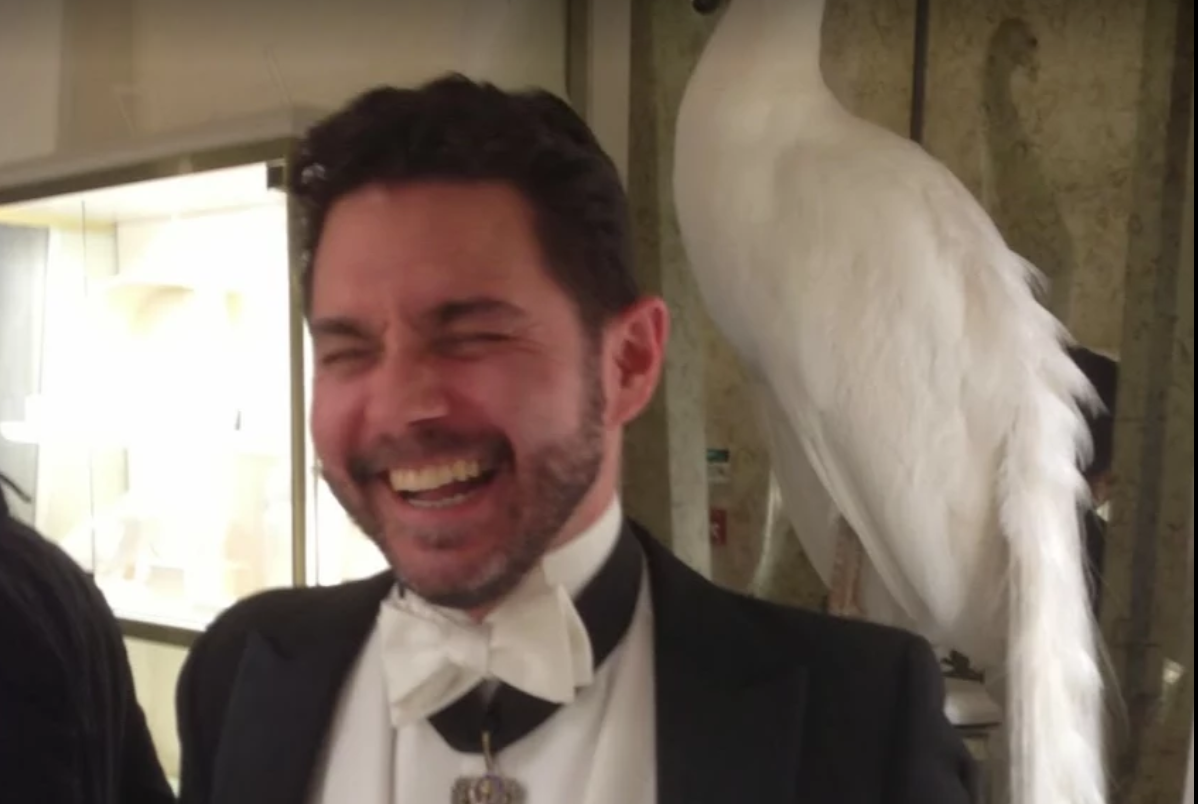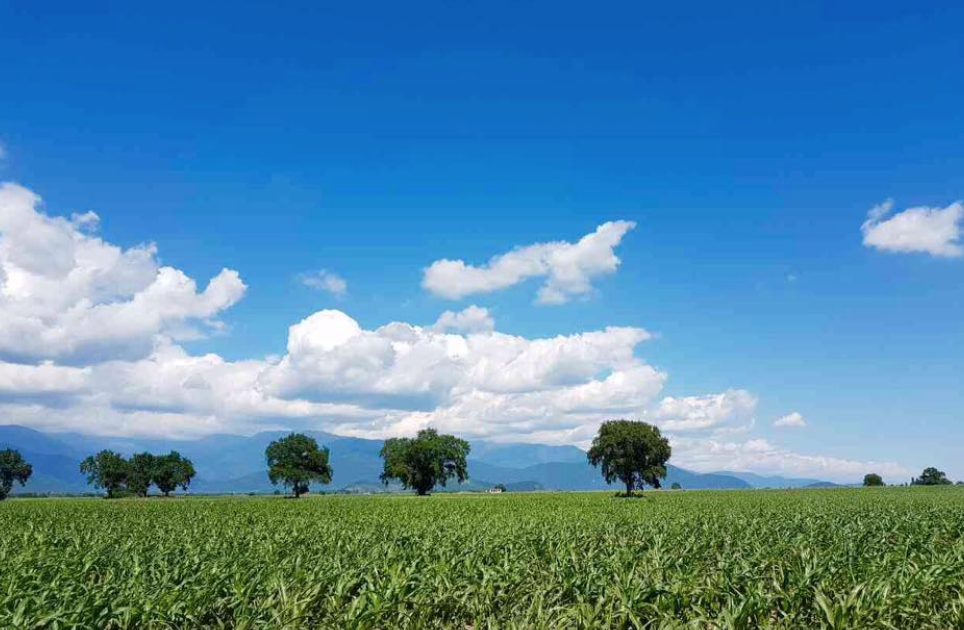
Situated at the foothills of the Caucasus Mountains in the Kakheti region of Georgia is Nine Oaks, an estate formed in 2011 as a collaboration among longtime friends focused on producing traditionally made Georgian wines. Nine Oaks Estate is named after nine oak trees (photo above) on the 20-acre estate where the indigenous varietals of Saperavi, Rkatsiteli, Khikhvi, and Kisi are cultivated.
According to Wines of Georgia, Georgia is home to roughly one-sixth of the world's total grape varieties, estimated at more than 500 distinct indigenous grapes. Grape Collective talks with Nine Oaks partner and creativer director Anna Addison about classic Georgian viticulture, the unique grape varieties native to the area, and natural winemaking in Kakheti.
Edward Marchese: Can you tell us a little bit about yourself and your vineyard?
Anna Addison: My name is Anna Addison. The vineyard is Nine Oaks, Nine Oaks Wine. We make wine the traditional Georgian way, the traditional Kakhetian way from the country of Georgia, which is bordered with Russia, Turkey, Armenia, Azerbaijan, in the east, in the Kakheti region of winemaking.
How long have you been making wine?
We planted the grapes in 2011 and I've been involved since 2017 as a partner and creative director. Our first vintage was in the market commercially in 2016.
Can you tell us a little bit about what makes this particular place that you're making wine special? A little bit about the terroir maybe, that's particular to that region?
Absolutely. Georgia is nestled between the Greater Caucasus and Lower Caucasus. The Kakheti is a wine region and we're nestled right at the foothills of the Caucasus Mountains, which is very important for the rocks and their minerals and the rocky soil is very important for the grapes. The Dutch did a discovery that the rocks are more important even than the soil to the winemaking, because the roots have a lot of way to distribute themselves and grab on and so it makes a very strong root structure. We're also located between three rivers, so a lot of really great climate and you have the whole valley, you have the wind going through the valley and then the soil and the water.
Now I understand that there's a very specific way that they make wine in Georgia with these very large ceramic pots. Can you explain that for us?
Yes, absolutely. Georgia is the cradle of viticulture, it has 8,000 years of viticulture and the Georgian method is on the UNESCO intangible cultural heritage list, the way the Georgians make the wine, so the Georgians make the wine.
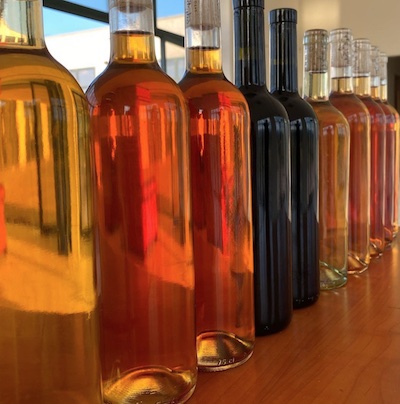 For example, this is a white wine grape, this is a Rkatsiteli. We have four different varieties, Kisi, Khikhvi, Rkatsiteli and Saperavi and the Georgians make white wine like they do the red. We use the skin, the juice and the pit to make the wine, which gives it this gorgeous amber color. This is the long skin contact, it's on the skin for one month, so 21 to 27 days. And we also make the wine in the amphoras. They're really big vessels that are buried underground, they're egg shaped with a little point and they're buried underground. This is where the wine is fermented, this is where the wine is stored and it's done so in order to keep the wine cool and then the same temperature when it's in the earth and also to keep it safe.
For example, this is a white wine grape, this is a Rkatsiteli. We have four different varieties, Kisi, Khikhvi, Rkatsiteli and Saperavi and the Georgians make white wine like they do the red. We use the skin, the juice and the pit to make the wine, which gives it this gorgeous amber color. This is the long skin contact, it's on the skin for one month, so 21 to 27 days. And we also make the wine in the amphoras. They're really big vessels that are buried underground, they're egg shaped with a little point and they're buried underground. This is where the wine is fermented, this is where the wine is stored and it's done so in order to keep the wine cool and then the same temperature when it's in the earth and also to keep it safe.
What's the time period like? Do you do something once it's out of there? Do you take it from there and bottle it, or how is that whole process is handled?
Absolutely, because this is our vineyard, it's very important for us to keep the quality, so it's great for us to have our vineyard versus for example, buying just wine from another vineyard because we know exactly what is going into the soil. We don't spray with anything. We don't use herbicides or coloring. It's also due to spontaneous yeast and we're able to harvest and make wine immediately. So during the harvest, we collect the grapes by hand and then it's going immediately into the marani, which is the Georgian name for winery and then we start making wine.
First, we separate the stems and then we keep the skin, the juice and the pit and the qvevri reserve. It goes into the qvevri, or the amphora, for one year. So first, it's fermented for 21 to 27 days and then it will go in and out where we separate it from the pumice about three or four times. So we take the wine out, clean it, then it goes back into the amphoras and we have classic wine and we have the amphorae wine, so the classic range stays in the qvevri for three to four months and then the reserve is there for one year, so it's a slow winemaking process.
How big is the winery? I know you mentioned it was fairly large acreage.
Correct. It’s 20 hectares of wine and spread around four different grape varieties. So, grape varieties, we have three whites and one red. We have more of the red and then on the like 20 hectares, I would say eight hectares of the red and the rest are four varieties of the white, we added one more.
Is there any particular grape, or any one of those that you really concentrate on?
Well Saperavi is a very well known red grape in Georgia.
Wonderful, I've had it.
Yes. It’s very special because it's a tenturier grape, where you have a red flesh on the inside, so in Georgia we call it the black wine. Then we have the white wine, where we make the amber wine and they're all quite different. They are very rare grape varieties that we're concentrating on bringing back and so the Kisi, Khikhvi and Saperavi we pretty much have an equal amount and they're quite rare for Georgia.
What would you say separates you from others in your region that are creating wine?
Right, well, I would have to start first with the winemaker, Mamuka Khurtsidze. He's an amazing person, he is a geo mapper, he's an environmentalist and he's just love wrapped up in a human body, he gives so much energy to the wine.
There's a cool story I can also tell you, that Mamuka's father, the winemaker, he was growing up making wine on the west side of Georgia and all of the neighbors are making wine and as a kid you're growing up and you're seeing everyone's making wine around you. He asked his dad, "Why is someone's wine really good and some wine is really bad?" Because everyone's making wine, he sees the same process, the growth, harvest and his father said, "A bad man can never make good wine."
I like that.
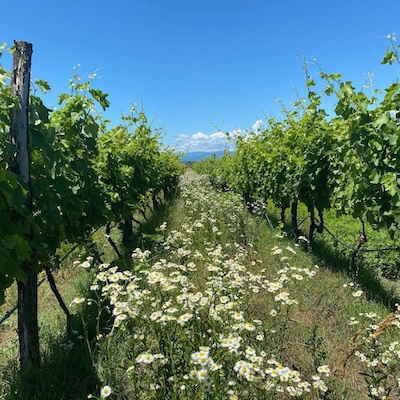 Another is we have our own vineyards so, I mean, we know the quality, we know exactly what's going in to the land and we don't add any herbicides, so that really separates us from the rest of winemakers. We make sure we have limited intervention. Like Mamuka says, we just watch and listen to the wine, we try not to meddle with it and we make our wine really the Georgian traditional method, which we do it with the skin. A lot of people don't do the Kakheti and traditional skin contact in the qvevri, they'll do a lot of it in the tank.
Another is we have our own vineyards so, I mean, we know the quality, we know exactly what's going in to the land and we don't add any herbicides, so that really separates us from the rest of winemakers. We make sure we have limited intervention. Like Mamuka says, we just watch and listen to the wine, we try not to meddle with it and we make our wine really the Georgian traditional method, which we do it with the skin. A lot of people don't do the Kakheti and traditional skin contact in the qvevri, they'll do a lot of it in the tank.
Can you give us a bit of a breakdown about the individual grapes that you're working with?
Yes, so we have Kisi, Khikhvi, Rkatsiteli, those are the white grapes, and the Saperavi. Khikhvi, and Kisi are quite a rare grape, I think for Khikhvi there's about a 100,000 hectares total left in Georgia. Georgia has 8,000 year viticulture of winemaking, but they used to sell the wine. They'd sell the grapes and they sold the juice, they only kept the wine for themselves, kind of their house wine and people would have the qvevri in the backyard that they would have for the year, so they did not make the wine for export. They did not make the wine to the bottle and would believe you have to go through the full cycle of making the wine to the end, to the bottle, in order for it to travel.
When the three partners got together, four partners, it's also women owned, three out of four are women.
Nice.
Yeah, Mamuka's wife and another friend of ours. So we wanted to show to the rest of the world that Georgia produces great wines and it's necessary for them to travel, so it's necessary to make wine for the full cycle when it goes into the bottle. We really encourage all of the young winemakers to make natural wine, to make biodynamic wine and not use all of the pesticides and other garbage that's going into wine. So we are really proud of that, that we know that it's natural. We know exactly what's going into our body, we know what's going into our wine.
You're saying you're focusing on making your wines as naturally as possible?
Correct.
What do you feel the state of organic or natural winemaking is like in your region? Are more and more people embracing it? How do you see all that happening?
I see it shifting a lot. The winemakers, they were growing the grapes, they were farming the grapes and they were selling the wine and that's a big difference between selling the wine and selling the grapes, versus making the wine and making it to the end to the bottle. Russia was a huge expert for Georgian wines, so the Khakhetians or different parts of Georgia, they would sell the wine to Russia and so except for themselves, for the house wine, they didn't make it to the very end. Now we see a lot of younger winemakers really going towards making the wine and making the wine to the end and making it, putting it in the bottle.
Do you think more and more people are going natural as opposed to just using pesticides?
Yes, absolutely right, exactly.
Can you give us a little overview on the natural wine movement and how it originated in Georgia, perhaps?
Let's see, so the viniculture in Georgia has been known for 8,000 years. It's a UNESCO heritage site where they did, I think carbon copy in UK and they determined that this is the oldest artifact and that the wine came from Georgia. In Georgia, this is the style, different parts of Georgia have different grape varieties. We are in the Saperavi microzone, so this is where we make the Saperavi and Rkatsiteli, then doing it with a long skin contact as we are keeping the tradition.
We are innovative though. We're a younger generation where we do the traditional methods, but we are using newer technologies. For example, because we don't add herbicides or pesticides to the ground, we have a machine specifically raised to cut the grass. Then we also make it the traditional method of making the wine in the qvevri.
How many qvevri do you have?
We have 20 qvevri, I think 18 or 17 of them are 2 ton, some are a 2 1/2 ton.
So about 38 ton volume, total.
How long does it take to make a qvevri?
To make a qvevri that size, it depends on who is making it, the person that we found to make the qvevri, they can make about 30 to 35 qvevri in one summer, because you need sunlight. You need sunshine for it to dry. Whenever they're making the qvevri they're doing about four inches in one day and there's no technology that touches it. So they make the clay sort of in this sausage and they spiral it around and around and then it has to dry and dry. It's pretty incredible to do volume just by hand.
It's a huge process.
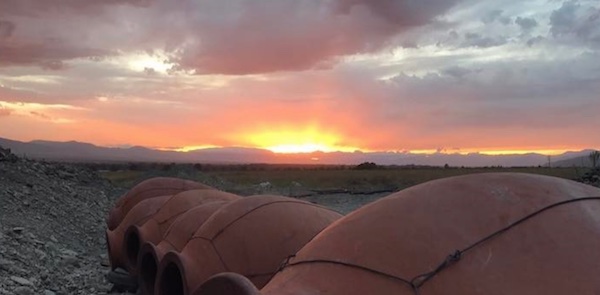 Exactly, so then it dries and they do it from the land and from the clay right where they live and when it dries in the sun, then it dries in kind of like this damp room. Then, they have an oven where they can put say, two two ton qvevris. They can only put two at a time, they break it up, they fire it up. Then they un-break it and it's quite a process where the neighbors come in that help and then they take the qvevri out, they're singing, they're singing wine songs, they're always singing around the vineyard. They really treat wine and wine making like church for them, they don't even cuss or think bad thoughts around the wine.
Exactly, so then it dries and they do it from the land and from the clay right where they live and when it dries in the sun, then it dries in kind of like this damp room. Then, they have an oven where they can put say, two two ton qvevris. They can only put two at a time, they break it up, they fire it up. Then they un-break it and it's quite a process where the neighbors come in that help and then they take the qvevri out, they're singing, they're singing wine songs, they're always singing around the vineyard. They really treat wine and wine making like church for them, they don't even cuss or think bad thoughts around the wine.
Whenever I'm tasting the wine around them, we don't talk about, is it there yet or not there yet or is it bad, because it really has an energy. Whenever the neighbors come in and they took the qvevri out of the oven, it's still hot, so they also put organic beeswax to line inside of the qvevri.
Oh, wow.
Yeah, so it's breathing, so in order to seal it we have to reseal it with beeswax about every five years. We just resealed a qvevri with beeswax once again.
During the process do you seal the top of it with beeswax or is there any kind of sealing that's done while the wine is fermenting?
Absolutely. Once the qvevri is already underground it's very interesting because you don't know. You go through the whole process and then you plant the qvevri in the ground and you don't know if it breaks or if it works until you test it out because of the volume, so before you plant it, you also have a limestone goes around it. So you have the limestone covering it and then you plant it in the ground and then you test it to make sure it doesn't leak, first with water and then when you pour in the wine, you seal it with clay, yeah.
You seal it up with clay?
Yeah, you seal it with clay until we have to take the wine out, put it back in, then it's sealed with clay again.
I'm glad that you're testing with water as opposed to wine because then, I mean, how often do these things break or how often do you run into a situation where it's just not going to work?
Yes, well that happened to qvevri, so we had to get it redone and you just don't know if something got cracked because of the a volume or something inside of it, yes.
No wonder why you're praying or having this whole religious experience, making the wine, anything can go wrong.
Exactly, exactly.
